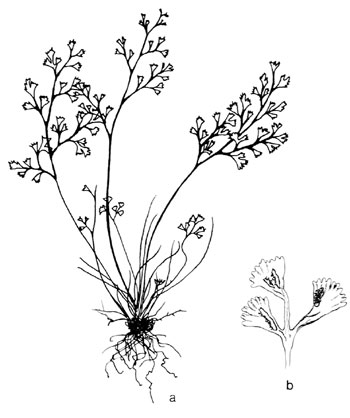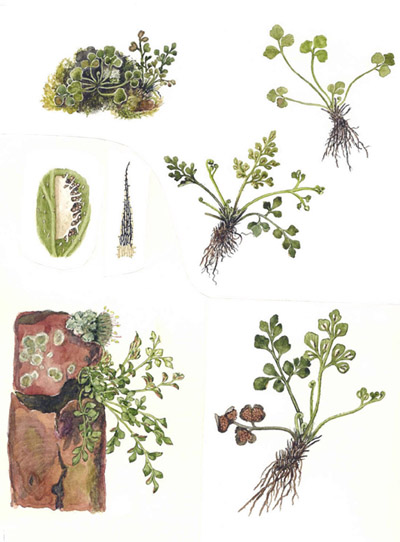| Asplenium ruta-muraria | ||
Wall rue | ||
|
Etymology
From ruta, the bitter herb rue + murus, a wall.
Description
Rhizome: erect, occasionally branching, scales clathrate, to 3mm, dark brown.
Frond: 15 cm high by 5 cm wide, evergreen, monomorphic, blade/stipe ratio: 1:2 to 1:1. Stipe: purple-brown at base, fading to green , dark brown, narrowly deltate scales at base grading into multicellular hairs, vascular bundles: 2 C-shaped, back to back, uniting to 1 upwards to an X-shape. Blade: 2-pinnate at the base, said to be occasionally more divided, always less upwards, oblong-triangular, leathery, dull, commonly with tiny glandular hairs and a few linear scales. Pinnae: 2 to 5 pair, opposite to alternate, anadromic, stemmed, variable in shape; margins serrate or creanate; veins free, forking. Sori: linear, along a vein, w-6 on each segment, indusium: translucent, pale tan, fimbriate, hidden by sporangia at maturity, on one side of the sorus, opening toward the middle of the segment, sporangia: brown, maturity: early summer to mid fall, but dispersal can extend. Culture
Habitat: rock crevices and screes, on limestone.
Distribution: Europe, northern Africa, Mideast, central Asia, Japan, eastern North America.
Hardy to -30�C, USDA Zone 4.
Synonyms
Asplenium cryptolepis Fernald Asplenium cryptolepis Fernald var. ohionis Fernald Asplenium ruta-muraria var. cryptolepis (Fernald) Wherry Amesium ruta-muraria (L.) Newman |
|
|

Asplenium ruta-muraria. a) fronds; b) fertile pinnules. �Illustration by V. Fulford from Ferns and Fern Allies of Canada, William J. Cody and Donald M. Britton, 1989, � Agriculture Canada, used with permission. |
